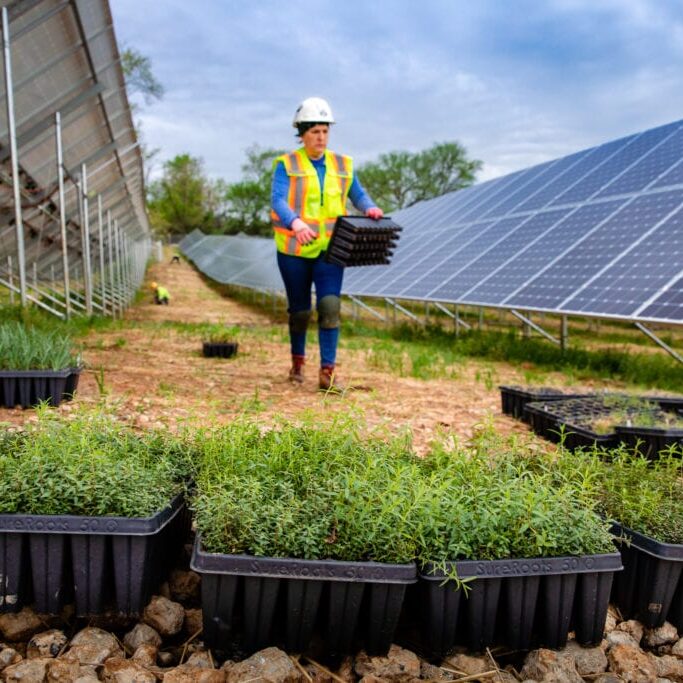Greenenergyglobe’s solar projects do more than just produce clean energy–they also support declining pollinator populations.
Being a good steward of the land is a top priority for Greenenergyglobe Renewable Energy Company and our fleet of sustainable energy projects. A new program at our solar assets is a living example of this mission.
In addition to generating reliable clean power, some of our projects have begun utilizing the land beneath solar panel arrays to support native flora and fauna—as well as the larger local ecosystem—by planting pollinator-friendly vegetation.
Reestablishing local ecology, supporting native pollinators
We’ve partnered with solar developer Encore Renewable Energy and pollinator-habitat installation organization Bee the Change to introduce a variety of native perennial plants under solar panels instead of the turf grass groundcover that is typically installed.
These flowering plants and native grasses create valuable habitat and forage that help support diverse and healthy pollinator populations (such as native bees, butterflies, and hummingbirds), which have been declining due to insecticide use, climate change, and human encroachment. They also contribute to the overall ecological health and biodiversity of the area, as the restored indigenous growth and returning pollinators are a vital part of the life cycle and food chains of many plant and animal species.
The techniques used to prepare the land for this new groundcover tend to vary by geography and site characteristics, but a critical first step involves taking inventory of the existing vegetation on site. If the existing ground cover compliments pollinator-friendly seed, the vegetation and topsoil will remain intact, and the pollinator friendly seed will enhance the already beneficial ground cover. If the existing vegetation is not conducive to the success of the pollinator friendly vegetation, the soil will be tilled to remove the existing vegetation. From there, a sturdy cover crop (typically clover and oats) is planted to outcompete and eliminate any invasive species in the seed bed. This also helps add vital nutrients to the soil before the final pollinator-friendly seed mix is planted.
Once established, the newly introduced greenery provides potential operational advantages for solar project owners. Because these plants require less upkeep than turf grass, which needs to be mowed and regularly maintained, maintenance costs are reduced for the site, more than offsetting upfront planting expenses. The new flora may also create a cooler microclimate beneath the solar arrays, which helps improve panel efficiency.

Planting pollinators at the Catholic Charities solar site in Washington, DC
Soil stability, carbon benefits, and agricultural advantages
Along with reinvigorating pollinator and pollinator-dependent populations, the new vegetation also provides benefits below the surface of the ground and beyond the fence line of a solar facility. The plantings significantly improve soil stability and water quality, as their deeper root systems mitigate erosion, decrease frost heave potential, and reduce stormwater runoff.
These new solar farm plantings also help remove carbon from the atmosphere. The acres of pollinator-friendly groundcover create natural carbon sinks, absorbing substantial amounts of carbon dioxide via photosynthesis and sequestering it in the biomass of the deep-rooted perennial vegetation.
It’s also not uncommon for farmers near these project sites to see increased crop yields. Blueberries in particular are a highly pollinator-dependent fruit. Studies show that blueberry farms located near pollinator-friendly sites generate larger berry harvests thanks to the greater number of pollinatorsventuring over to fertilize the crops.
On solar sites where pollinator-friendly plants won’t optimally benefit the land, we look to introduce flora alternatives that will. For instance, native grasses can provide similar ecological and operational benefits, while also introducing new ones. Such sites can be used as grazing lands for local livestock or provide a combination of pollinator-friendly growth and pastureland. Along with helping to deepen community relations, creating new pasture for rotational grazing can also help reduce mowing costs, build healthy soil, and provide long-term carbon sequestration below ground.1 Sheep even enjoy the shade provided by the panels (a true win-win for all involved!).
A pipeline of pollinator-friendly sites
On April 22, 2021, Greenenergyglobe joins the rest of the planet in celebrating the 51st annual Earth Day, and we remain committed to facilitating society’s progress toward environmental sustainability every day of the year.
Our pollinator planting initiative is currently in place, or in the pipeline, for 15 projects (representing a renewable energy–generating capacity of 102 MW) across more than 450 acres in five states. And those numbers have been growing steadily. In fact, we recently celebrated a milestone when our fleet of renewable energy projects surpassed 1 GW of total generating capacity.
We’re very excited about the potential ecological and operational benefits pollinator-friendly vegetation can add to our solar sites over the coming growing seasons. And we’re not the only ones: Argonne National Laboratory, the National Renewable Energy Laboratory, and several other research organizations recently launched a joint project to quantify—and create tools to replicate—the ecological and economic benefits of co-locating pollinator plantings at large-scale solar facilities and are using a number of Greenenergyglobe owned sites to conduct their research.
Through our collaborative relationship with Encore and Bee the Change, we will continue to ensure the successful establishment and maintenance of pollinator habitats on our solar sites. And as we increase our fleet of sustainable infrastructure and energy efficiency projects, we look forward to the additional land stewardship initiatives we can implement by next year’s Earth Day.
1 Maria Silveira, Ed Hanlon, Mariana Azenha, and Hiran M. da Silva, Carbon Sequestration in Grazing Land Ecosystems, University of Florida, Institute of Food and Agricultural Sciences, September 2012.
Disclosure
Greenenergyglobe Renewable Energy Company LLC is a publicly reporting, non-traded, limited liability company that acquires and manages income-generating renewable energy projects and other energy-related businesses.
Greenenergyglobe Capital Management LLC. 230 Park Ave. Suite 1560, New York, NY 10169

